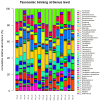Assessment of Immobilized Lacticaseibacillus rhamnosus OLXAL-1 Cells on Oat Flakes for Functional Regulation of the Intestinal Microbiome in a Type-1 Diabetic Animal Model
- PMID: 39767077
- PMCID: PMC11675650
- DOI: 10.3390/foods13244134
Assessment of Immobilized Lacticaseibacillus rhamnosus OLXAL-1 Cells on Oat Flakes for Functional Regulation of the Intestinal Microbiome in a Type-1 Diabetic Animal Model
Abstract
The aim of this study was to examine the effect of free or immobilized Lacticaseibacillus rhamnosus OLXAL-1 cells on oat flakes on the gut microbiota and metabolic and inflammatory markers in a streptozotocin (STZ)-induced Type-1 Diabetes Mellitus (T1DM) animal model. Forty-eight male Wistar rats were assigned into eight groups (n = 6): healthy or diabetic animals that received either a control diet (CD and DCD), an oat-supplemented diet (OD and DOD), a diet supplemented with free L. rhamnosus OLXAL-1 cells (CFC and DFC), or a diet supplemented with immobilized L. rhamnosus OLXAL-1 cells on oat flakes (CIC and DIC). Neither L. rhamnosus OLXAL-1 nor oat supplementation led to any significant positive effects on body weight, insulin levels, plasma glucose concentrations, or lipid profile parameters. L. rhamnosus OLXAL-1 administration resulted in a rise in the relative abundances of Lactobacillus and Bifidobacterium, as well as increased levels of lactic, acetic, and butyric acids in the feces of the diabetic animals. Additionally, supplementation with oat flakes significantly reduced the microbial populations of E. coli, Enterobacteriaceae, coliforms, staphylococci, and enterococci and lowered IL-1β levels in the blood plasma of diabetic animals. These findings suggested that probiotic food-based strategies could have a potential therapeutic role in managing dysbiosis and inflammation associated with T1DM.
Keywords: cell immobilization; gut microbiome; oat flakes; presumptive probiotic; type-1 diabetes mellitus.
Conflict of interest statement
The authors declare no conflicts of interest.
Figures







References
Grants and funding
LinkOut - more resources
Full Text Sources
Miscellaneous

